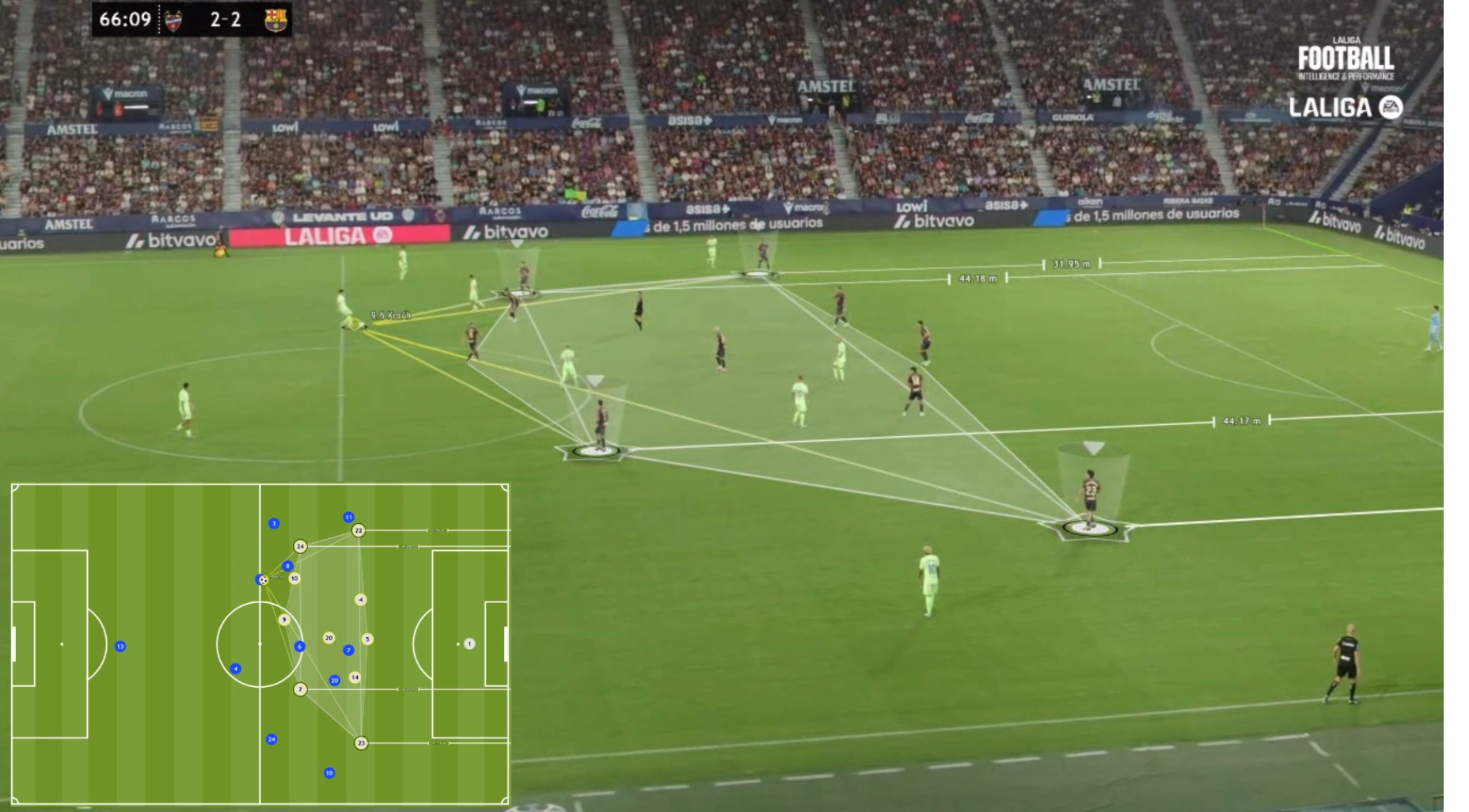
19 Sep “If the ball leads and the block doesn’t follow, you break.”
A live problem on the touchline
The opponent circulates from left to right and your back four shuffle… almost. One wide midfielder lags half a step, the full-back tucks too early, and a passing lane opens across your box. Nothing “catastrophic” on the GPS sheet—but the block has lost synchrony with the ball. Two passes later, you’re defending a cut-back.
This post translates a peer-reviewed study by the Football Intelligence & Performance Department at LALIGA into applied guidance for coaches, physical trainers and analysts. The work introduces a ball-referenced model of defensive block synchrony, designed to run live and trigger meaningful alerts—so staff can coach decisions, not just collect data.
Introduction — Why synchrony, why ball-referenced?
Traditional defensive analysis leans on possession %, PPDA, or heat maps. Useful, but none tell you whether your collective shape is moving with the ball. Our research asks a sharper question:
Given where the ball is right now, is our defensive block behaving the way our team intends to defend?
To answer, we observe the defending team relative to the ball and the rational pitch geography coaches use daily: four vertical lanes (left, left-central, right-central, right) crossed with four depth zones (first to last quarter). In each of the 16 cells, teams have recognisable defensive fingerprints—compactness, line height, band synchrony—that can be learned and monitored in real time.
What this refines:
- Confirms the long-held principle that compactness is context-dependent—acceptable width and depth when the ball is on one side aren’t acceptable when it’s on the other.
- Challenges the assumption that one league-wide threshold fits all; team identity matters.
- Extends prior work on pitch control and defensive organisation by giving staff a live, ball-anchored trigger they can coach against.
Methods — How the model “sees” your block
Objects tracked (excluding the goalkeeper):
- Ball coordinates and velocity.
- Defending outfield players (10).
Core geometry:
- Convex hull area of the defending team to quantify compactness in each frame.
- Centroid of the hull to capture collective shift.
- Four wide reference players (two defenders, two midfielders nearest to the flanks). We draw ball-to-band cones on both sides; their angle/length reveal lateral synchrony.
- Distance of the four wide players to own goal-line as a simple but powerful proxy of block height.
Contextual grid (coach-friendly):
- 4 lanes × 4 depth zones define the location of the ball. Expected behaviours differ cell by cell.
Team-aware baselines:
- For every team, the model learns distributions (not single numbers) for: hull area, width, depth, cone symmetry, and line-to-goal distances in each cell.
- Baselines adapt to contextual identity (typology of players, system, tempo of circulation, channeling preferences).
Alert logic (live):
- A frame triggers an Early Warning when a metric drifts outside the team’s normal band for that ball cell.
- Risk and Critical alerts require either larger departures or the co-occurrence of multiple deviations (e.g., hull inflates + cone breaks + line height inconsistent with ball depth).
- Short windows smooth noise so the system rewards sustained synchrony rather than isolated steps.
Why this matters: staff don’t coach abstract averages; they coach timing and spacing as the ball moves. The method turns that reality into measurable, actionable signals.
Results — What changes when you make the ball your reference?
Across anonymised match samples, three patterns consistently emerged:
- Synchrony is cell-specific
- Teams that look compact with the ball wide often look too large with the ball central. The model reveals these asymmetries, which are invisible to global compactness metrics.
- Team identity governs thresholds
- High-line, proactive blocks can carry larger hulls high up the pitch without risk; reactive blocks can tolerate deeper lines but pay a price if width expands when the ball is central. A single league threshold would mislabel both.
- The bands are your metronome
- The four wide players act like a timing belt. When their ball-to-band cones lose symmetry or the near-side cone opens too quickly after switches, penetrations spike. Re-establishing cone integrity correlates with stopping entries.
These findings align with prior literature showing that defensive compactness and coordinated lateral shifts reduce shot creation and central entries, while poorly timed width or depth increases progressive passes and cut-backs. Our contribution is a live, ball-anchored lens that respects team identity and gives coaches direct levers on the training pitch.
Practical applications — What different team types gain
1) High-pressing, high-line teams
- What often goes wrong: the back line steps, but wide midfielders under-travel during rapid switches; the far-side cone opens.
- Model benefit: early warnings when cone symmetry breaks during ball travel; coaching cue: sprint standards and body orientation for far-side band; rehearse “carry + switch” scenarios to keep cone angles stable.
2) Mid-block zonal teams
- Typical risk: over-protect central lanes when the ball is wide; width balloons unnoticed; weak-side half-space becomes free.
- Model benefit: lane-specific thresholds flag excess width only when the ball is central; design task: 8v8+2 with mandatory lane switches where the block must recover cone integrity in ≤2 passes.
3) Low-block reactive teams
- Typical risk: depth creep—line sinks five metres when the ball reaches the last quarter, inviting cut-backs.
- Model benefit: goal-line distance of wide players monitored as a simple height proxy; coaching cue: “step to the touch” rules when the ball leaves the wing channel; rehearse clear step-lines after partial clearances.
4) Possession-dominant teams (rarely defend for long)
- Typical risk: short defensive phases lack rhythm; one player fails to join the collective shift.
- Model benefit: micro-alerts in the few minutes defending; practical use: post-game clips for learning; build micro-blocks in training (40–60s defending with directed switches) to automate the response.
5) Transition-heavy, direct teams
- Typical risk: excellent at counter-pressing first pass, but if the ball escapes to the far side the block can over-chase.
- Model benefit: the model treats change of lane at speed as a risk amplifier; training lever: include bounce passes that force the second shift; check if cone symmetry holds beyond the first trap.
6) Wing-centric crossing teams
- Typical risk: near-side band jumps early to block the crosser; central compactness loosens with the ball still wide.
- Model benefit: hull inflation flagged relative to a wide-ball cell; session design: crossing defense with strict central spacing targets while the ball is still in the wing corridor.
7) Man-oriented pressing teams
- Typical risk: individual references pull players off the collective grid when the ball changes quadrant.
- Model benefit: deviations are judged against team baselines per ball cell, helping staff separate useful man-references from shape-breaking over-pursuits; coaching cue: “switch: abandon, re-sync with ball”.
Discussion — From assumptions to tested behaviour
- Assumption tested: “Compactness wins.”
Refined: Compactness relative to ball location wins. Acceptable width/depth depends on lane and quarter. - Assumption tested: “We can benchmark teams to the same standard.”
Refuted: Identity matters. Team-aware thresholds reduce false positives and reveal genuine weaknesses. - Assumption tested: “Most defensive issues are central.”
Challenged: Many collapses start with cone failure on the far side during switches; the centre only receives the consequence.
These insights resonate with studies connecting collective spacing, synchronised lateral movement and controlled line height to fewer dangerous entries and shots. Our model operationalises those principles for live decision-making and targeted training.
Conclusions — What to take to training tomorrow
- Coach the bands: treat the four wide players as synchrony anchors; monitor their cone and goal-line distance.
- Train by cell: build drills by ball lane/quarter and grade success by holding your team’s own baselines.
- Review live alerts with video: reinforce the behaviour immediately; the eye learns faster with ball-anchored evidence.
- Update baselines over time: as systems evolve, so should thresholds—identity is stable, not static.
How to implement on matchday (checklist)
- Pre-match: load opponent tendencies; set your team’s baselines by ball cells.
- In-game: alert levels (Early/Risk/Critical) pushed to the analyst; validate with the live overlay.
- Post-match: 16-cell map of alert density, plus 6–8 clips where synchrony was regained (not just lost).
Limitations to keep in mind
- Tracking quality & camera calibration can affect hull and cone accuracy.
- Role detection for the four wide players must be robust to in-game rotations.
- Context shifts (new coach, structural changes) require re-centering baselines.
- Restarts and transitions need dedicated profiles; they aren’t “set play” versions of settled defence.


